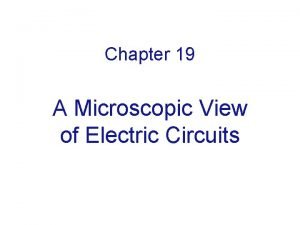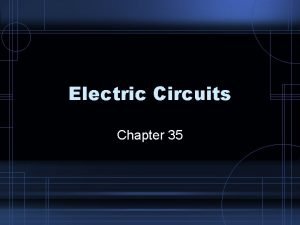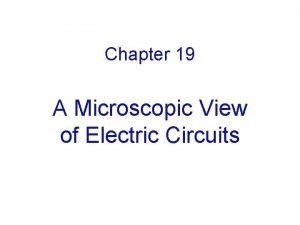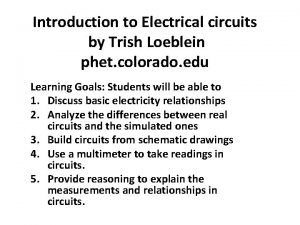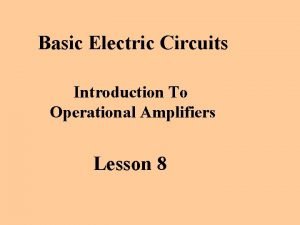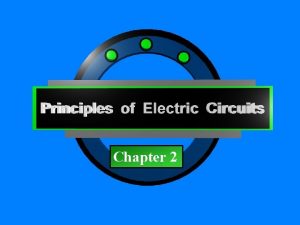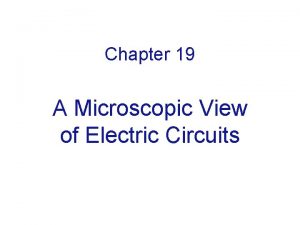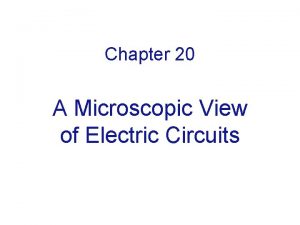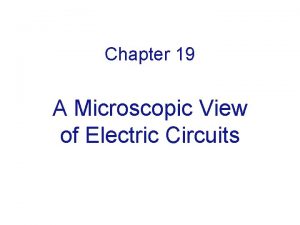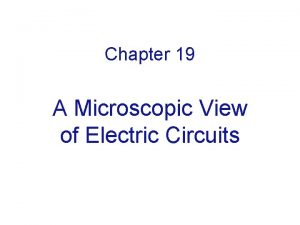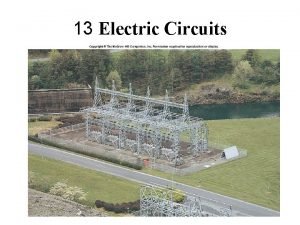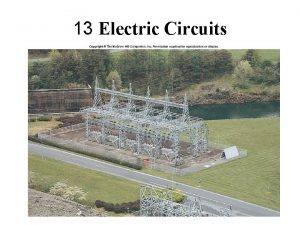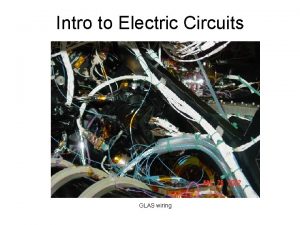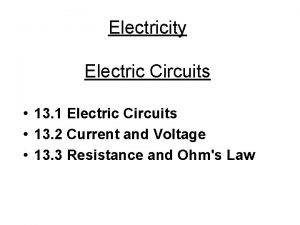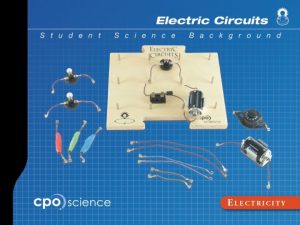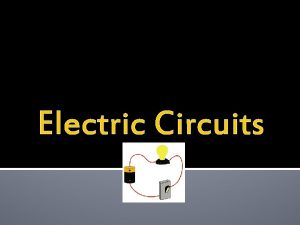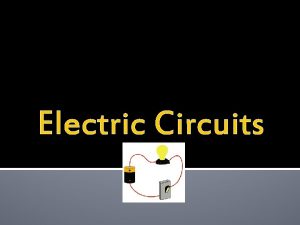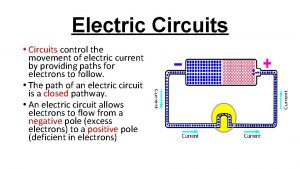Chapter 19 A Microscopic View of Electric Circuits





















- Slides: 21

Chapter 19 A Microscopic View of Electric Circuits

Current at a Node The current node rule (Kirchhoff node or junction rule [law #1]): i 1 = i 2 = i 3 + i 4 In the steady state, the electron current entering a node in a circuit is equal to the electron current leaving that node (consequence of conservation of charge) Gustav Robert Kirchhoff (1824 - 1887)

Analysis of Circuits The current node rule (Charge conservation) Kirchhoff node or junction rule [1 st law]: In the steady state, the electron current entering a node in a circuit is equal to the electron current leaving that node Conventional current: I = |q|n. Au. E The loop rule (Energy conservation) Kirchhoff loop rule [2 nd law]: V 1 + V 2 + V 3 + … = 0 along any closed path in a circuit V= U/q energy per unit charge

Clicker Pick right statement: A) i 1 = i 4 and i 2 = i 3 B) i 1 i 4 C) i 1 = i 4 and i 1= i 2+i 3

Question Write the node equation for this circuit. What is the value of I 2? A) B) C) D) 1 A 2 A 3 A 4 A

Exercise Write the node equation for this circuit. What is the value of I 2? I 1 + I 4 = I 2 + I 3 I 2 = I 1 + I 4 - I 3 = 3 A What is the value of I 2 if I 4 is 1 A? I 1 + I 4 = I 2 + I 3 I 2 = I 1 + I 4 - I 3 = -2 A 1 A Charge conservation: Ii > 0 for incoming Ii < 0 for outgoing

Motion of Electrons in a Wire In a current-carrying wire there must be an electric field to drive the sea of mobile charges. What is the relationship between the electric field and the current? Why is an electric field required? Interaction between electrons and lattice of atomic cores in metal. Electrons lose energy to the lattice. Electric field must be present to increase the momentum of the mobile electrons.

The Drude Model Average ‘drift’ speed: - average time between collisions For constant temperature u – mobility of an electron Electron current: Paul Drude (1863 - 1906)

Typical Mobile Electron Drift Speed Typical electron current in a circuit is ~ 1018 electrons/s. What is the drift speed of an electron in a 1 mm thick copper wire of circular cross section?

Typical Mobile Electron Drift Speed Typical electron current in a circuit is 1018 electrons/s. What is the drift speed of an electron in a 1 mm thick copper wire? How much time would it take for a particular electron to move through a piece of wire 30 cm long? How can a lamp light up as soon as you turn it on?

Typical E in a Wire Drift speed in a copper wire in a typical circuit is 5. 10 -5 m/s. The mobility is u=4. 5. 10 -3 (m/s)/(N/C). Calculate E. Electric field in a wire in a typical circuit is very small

E and Drift Speed In steady state current is the same everywhere in a series circuit. i Ethin Ethick i What is the drift speed? Note: density of electrons n cannot change if same metal What is E?

Clicker A B Lamps are identical Batteries are identical In B batteries are connected in series Lamp shines brighter in A) A B) B C) Lamps in A and B have the same brightness

Two Batteries in Series Why light bulb is brighter with two batteries? Two batteries in series can drive more current: Potential difference across two batteries in series is 2 emf doubles electric field everywhere in the circuit doubles drift speed doubles current. Work per second:

Energy in a Circuit Vwire = EL Vbattery = ? Energy conservation (the Kirchhoff loop rule [2 nd law]): V 1 + V 2 + V 3 + … = 0 along any closed path in a circuit V= U/q energy per unit charge

Question: Twice the Length 1 2 i 1 i 2 Nichrome wire (resistive) A) i 1 = i 2 B) i 1 = 2*i 2 C) i 1 = ½ i 2

Question: Two Light Bulbs In series Parallel Identical light bulbs are first connected in series then parallel Will there be a difference in light brightness? A) There will be no difference B) In series connection will give brighter light C) Parallel connection will give brighter light

Two Light Bulbs in Parallel L … length of bulb filament 1. Path ABDFA: 2. Path ACDFA: 3. Path ABDCA: F i. B = i C ibatt = 2 i. B We can think of the two bulbs in parallel as equivalent to increasing the cross-sectional area of one of the bulb filaments.

Two Identical Light Bulbs in Series Two identical light bulbs in series are the same as one light bulb with twice as long a filament. Identical light bulbs Electron mobility in metals decreases as temperature increases! Conversely, electron mobility in metals increases as temperature decreases. Thus, the current in the 2 -bulb circuit is slightly more than half of the one-bulb circuit.

Long and Round Bulb in Series only round bulb: The round bulb doesn’t light up!

How Do the Currents Know How to Divide?
 Microscopic view of current
Microscopic view of current Fundamentals of electric circuits chapter 4 solutions
Fundamentals of electric circuits chapter 4 solutions Chapter 20 electric circuits
Chapter 20 electric circuits Conceptual physics chapter 35
Conceptual physics chapter 35 Chapter 20 electric circuits
Chapter 20 electric circuits Fundamentals of electric circuits chapter 9 solutions
Fundamentals of electric circuits chapter 9 solutions Fundamentals of electric circuits chapter 7 solutions
Fundamentals of electric circuits chapter 7 solutions Chapter 35 electric circuits answers
Chapter 35 electric circuits answers Ohms law worksheet
Ohms law worksheet Chapter 35 electric circuits
Chapter 35 electric circuits Microscopic view of current
Microscopic view of current Capillary condensation
Capillary condensation Series parallel circuit current
Series parallel circuit current Chapter 21 electric charge and electric field
Chapter 21 electric charge and electric field Chapter 21 electric charge and electric field
Chapter 21 electric charge and electric field Coulombs constant units
Coulombs constant units Units of a charge
Units of a charge Phet circuit
Phet circuit Electric circuits equations
Electric circuits equations Electric circuits nilsson
Electric circuits nilsson Principle of electric circuit
Principle of electric circuit Electrical circuit elements
Electrical circuit elements
